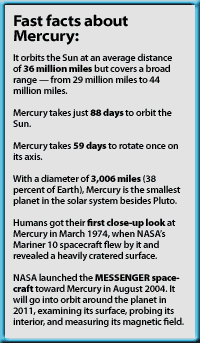
Mercury – a rare sight to behold
Once you spot Mercury, you may wonder why it has a reputation for being elusive. It is, after all, one of the sky’s brightest objects. Unfortunately, this bright light never climbs high in the sky. Mercury orbits closer to the Sun than any other planet so, from our perspective, it never strays far from the Sun’s glare. Even at its best, the innermost planet lies low in the west shortly after sunset or low in the east before sunrise. It never gets far enough from the Sun to appear in a dark sky.
The great astronomer Nicolas Copernicus (1473-1543) – the man who put the Sun in its proper place at the center of the solar system, with Earth circling it – reportedly never glimpsed Mercury. So take a few minutes one of these balmy August mornings, and catch a sight few people ever have.
Sneak preview of Mercury’s November transit of the Sun
Mercury transits – passes in front of – the Sun only 13 times a century, so don’t miss the chance to view this rare event November 8. A small telescope and a good solar filter are all that’s needed to watch the planet’s black disk cross the Sun.
Matt Quandt
Public Relations Specialist
[t] 262.796.8776 x419
[e] mquandt@kalmbach.com
August 2, 2006
More in the sky for the unaided eye (August 2-13):
Astronomy news
This week’s sky events
Astronomy basics
Glossary of astronomical terms
Return to Astronomy “For the media” page WAUKESHA, WI – For those who like to get up early, the first half of August offers great views of the solar system’s most elusive naked-eye planet. Mercury climbs into view in the east-northeast during the first few days of the month, appearing as a pale-yellow dot low in the morning twilight. Venus points the way
Although Mercury shines brightly, it can be hard to pick out against the twilight glow. Fortunately, the planet Venus serves as a terrific guide. Venus shines brighter than any other point of light in the sky. Head outside about 45 minutes before sunrise, find yourself an observing location with an uncluttered eastern horizon, and the brilliant planet will dazzle your eye.
Between August 6 and August 15, Mercury lies just below Venus. Although Venus gleams more than 10 times brighter than Mercury, you should be able to spot Mercury without much difficulty. If you don’t see Mercury right away, try finding it with binoculars. Once you know where to look, Mercury will pop into view. The two planets become more prominent as they climb higher in the sky – the best views will come about half an hour before sunrise.
Mercury reaches the peak of this morning appearance August 6, when it lies farthest from the Sun and climbs highest in the predawn sky. It then appears 10° – the approximate angle of your closed fist held at arm’s length – above the horizon 30 minutes before the sunrise. Mercury remains near this altitude for about 10 days and then starts sinking toward the horizon. It will pass Saturn, which is climbing away from the horizon, August 21. The morning after that, a slender crescent Moon joins the group.









